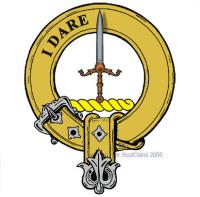
Clan Dalziel
The most popular derivation of the name Dalziel is the gaelic 'dal-gheail' meaning 'white meadow', referring to the colour of the local soil. There are so many different forms of this name that over 200 have been recorded.
The name originates in Lanarkshire, although it can also be found in Shetland, being named for the island of Yell (the two are most likely not related). The clan coat of arms features a hanged man, which is believed to be inspired by an event from the time of King Kenneth II. A member of the court went into enemy territory to retrieve the body of a friend of the King. This event also inspired the clan motto 'I dare'.
One of the earliest historical records of the clan name is in 1296 when Thomas de Dalziel appears in the Ragman Roll, giving allegiance to English King of that time, Edward I. There is also mention of a Thomas de Dalziel who fought alongside Robert the Bruce at Bannockburn. If these references are to the same man, we must presume that he changed sides at some point.
In 1390 Sir William de Dalziel joined Sir David Lindsay at the London Bridge Tournament. Sir William had lost one eye during the Battle of Otterburn, in 1388, and it is said that he suggested that all the contestants should have one eye put out, for the sake of equality! The Laird of Dalzell descended from Robert Dalzell), fought at Langside in 1568 for Mary Queen of Scots. His heir, Lord Dalzell was made Earl of Carnwath in 1639 by Charles I, after purchasing the Carnwath Estate in 1630.
Robert Dalzell, the second Earl of Carnwath was given a charter in 1635, which raised all the lands of Dalzell into a Barony. He was later found guilty of treason for betraying Parliament in the King's presence. As punishment, he was stripped of his title, rank and land, also being fined 100,000 Scots merks. His son Gavin inherited the title, but had to sell Dalzell Castle and lands to James Hamilton of Boggs (his cousin).
In the 18th century Sir Robert Dalzell, the fifth Earl lost his title and lands after fighting alongside James Francis Edward Stewart in the Jacobite rebellion of 1715.
Sir Thomas Dalyell of West Lothian belonged to one of the oldest branches of the family, fought for Charles I during the Civil War. After fighting in the Battle of Worcester in 1651, he was sent to the Tower of London. After escaping, he travelled to Russia, where he served the Tsar as a general of cavalry. He returned in 1666, when he was made Commander-in-Chief of the Forces in Scotland by Charles II. In 1681 he formed the regiment of The Scots Grays, which defeated the Covenanters at the Battle of Rullion Green.
The Dalyell's residence is The House of Binns near Linlithgow, and was built in the early 17th century by Sir Thomas's father, with various later additions. The house has had many Royal visitors, including five of Queen Victoria's children. The King's Room was decorated in anticipation of a visit by Charles I, but was never used by the king as he decided to stay Linlithgow Palace instead.
It was gifted to the National Trust for Scotland in 1944, although the family retains the right to live in part of the property.








